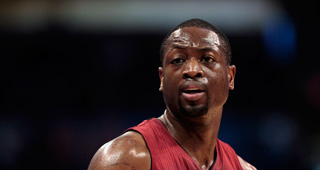When the Miami Heat formed their Big Three in 2010, most of the questions centered around LeBron James and Chris Bosh, the two stars who brought their talents to South Beach. Dwyane Wade, the MVP of the 2006 NBA Finals, had already proven himself at the highest level. Two years later, the dynamic has reserved: LeBron and Bosh are settled into defined roles on a championship team while Wade will have to tweak his game to fit with them.
The Heat have never had any real chemistry problems off the court, a credit to the unselfishness of their three stars, as well as the environment created by Pat Riley and Erik Spoelstra. Instead, on-court issues have been their biggest concern. When they opened the 10-11 season, they started two non-shooters in Joel Anthony and Carlos Arroyo, which caused significant floor spacing problems since neither Wade nor LeBron were great perimeter shooters either.
Over the next two years, Spoelstra relentlessly tinkered with his rotation as Miami churned the bottom of their roster. They stumbled upon a solution in the 2012 NBA Finals, with a uber small-ball frontcourt of Bosh, LeBron and Shane Battier. In Game 2, Spoelstra started Bosh at the 5 and LeBron at the 4 and the Heat never looked back, taking the next four games from an Oklahoma City Thunder team many considered the favorite going into the Finals.
Bosh's jump-shooting ability at 6'11 235 dragged opposing centers out of the paint, while LeBron embraced playing out of the high post as a 6'9 265 power forward. Wade was the secondary ball-handler and shot creator on the perimeter while the other two slots on the floor were filled by a combination of Battier, Mario Chalmers, Norris Cole and Mike Miller. With shooters spacing the for LeBron and Wade, Miami looked like the juggernaut everyone expected them to be in the heady days after "The Decision".
The Heat were the culmination of the positional revolution, perfecting a formula that Team USA copied in the London Olympics. However, that revolution was based upon the changing nature of the game: neither the Thunder nor the other 11 national teams in London had the type of dominant low-post threat at center that could punish an undersized team. In the Finals, Miami often played the 6'8 Battier on Oklahoma City's centers, daring them to run their offense through Kendrick Perkins.
As the Thunder found out, there's no way to beat the Heat at their own game. The only real threat to Miami is a team built around a dominant center, who can force them to field a more traditional lineup that negates their edge in speed and shooting. Andrew Bynum may one day be that player, but for now, a healthy Dwight Howard is the one thing standing in the way of a potential Miami dynasty.
In a NBA Finals matchup with the new-look Lakers, who can field two skilled and athletic 7'0's, the Heat would probably have to put a more limited center on the floor to help Bosh and LeBron. Having another non-shooter on the floor, in turn, would shrink the court offensively. Spoelstra isn't going to want his 6'9 265 point forward operating 25 feet from the rim, which is where Wade comes in.
The smallest (6'4 220) and oldest (30) of Miami's Big Three, Wade's longevity is the biggest question mark about their future. With a devastating first step and an absurd 6'11 wingspan, Wade became the NBA’s best shooting guard by living in the paint, either finishing over bigger defenders, drawing fouls or finding open shooters. Unfortunately, due to the decline of his 2006 supporting cast, some of his best seasons -- 30 points, 7.5 assists and five rebounds on 49% shooting in 2008; 27 points, 6.5 assists and 5 rebounds on 48% shooting in 2009 -- slipped under the radar on underwhelming Heat teams.
The only hole in his game has been his outside shooting. While he's never been an abysmal three-point shooter, he has a career average of only 29% from long range. Now, like Jordan and Kobe before him, he'll need to develop his perimeter shot in order to maintain his production into his 30's.
If Wade can consistently knock down three-pointers at a 35-40% clip, it would give Spoelstra a lot more room to shuffle his lineups. He could sacrifice shooting in the frontcourt to match-up with bigger teams, with Wade, Bosh and either Ray Allen, Chalmers or Battier providing the spacing necessary for LeBron and another big man to operate in the paint.
Adding a three-point shot, meanwhile, would add years to the back end of Wade's career. There's no better example of that than Jason Kidd, once dubbed "Ason" for his lack of a J as a younger player. Kidd, recognizing that age was slowing him down, reinvented himself as one of the NBA's most consistent knock-down shooters in Dallas, with two seasons above 40% from the 3.
Wade, in many ways, is a mini-LeBron, an all-around force who can affect the game as an elite scorer, passer, rebounder and defensive player. But while LeBron needed to bring his game closer to the basket, Wade needs to bring his farther away. How many titles Miami wins, and how far he ascends in the NBA’s all-time hierarchy, is in his hands. Or more accurately, his jumper.

Jonathan Tjarks wrote on the NBA for RealGM from 2011-2016 before joining The Ringer.
Follow @JonathanTjarks on Twitter.


